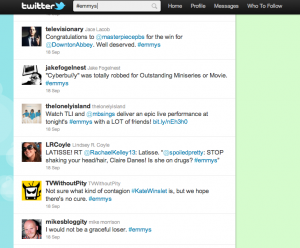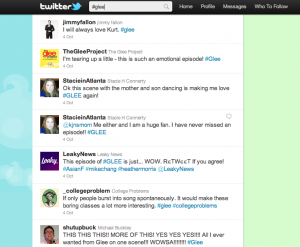Twitter is increasingly offering alternative narratives to broadcast events, such as award ceremonies and sports finals, where Twitter provides an alternative, collective commentary that unfolds in real-time alongside these real events:
It is also used by fan communities to share their experiences while watching new episodes of shows such as Glee:
I am particularly interested in the commentary that takes place alongside live broadcasts of award shows. This study topic draws upon work on internet studies in the domains of collective intelligence, transmedia and social networking. According to Henry Jenkins, “[c]ollective intelligence refers to [the] ability of virtual communities to leverage the combined expertise of their members. What we cannot know or do on our own, we may now be able to do collectively” (2006: 27). This describes the hashtagged tweetstream, as the participants voluntarily gather around a shared topic of interest to produce a text that exceeds the knowledge or viewpoint of any single contributor. The Twitter text exemplifies the different perspectives through which knowledge is mediated, and the technological platforms that allow broad participation and the open display of collective intelligence. The knowledge in this scenario is a reading of the television event, which can be subversive and personalized as a parallel narrative that runs alongside the broadcaster’s narrative.
While drawing on elements of collective intelligence and transmedia, this Twitter community and the text produced are distinct in several ways. While transmedia is conventionally seen as a way of deepening knowledge of a story, i) a broadcast awards event is not a conventional fictional narrative ii) the members participating in these communities cannot really be considered fans, and iii) the platform and content of this tweetstream generally provides a fragmented, rather than more profound, reflection on the event.
Fragmentation occurs due to the volume of tweets – a reader or participant cannot realistically read all the tweets as they appear in real time. Neither is the Twitter interface designed for a linear and comprehensive reading; it is more likely that users are toggling between watching the broadcast and tweeting, as well as reading tweets. Moreover, participants regard themselves as tweeting to multiple audiences (boyd & Marwick, 2010). Without the express purpose of trying to clearly articulate information to a defined audience, tweeters post tweets that are in different languages; meaningful only to a single recipient; cryptic; and that speak out against the topic.
Despite this tendency towards fragmentation and partial perspectives, it is argued that this collective intelligence community is valuable, both in terms of the knowledge produced and as an area of research. In terms of the narrative written by tweeters, if the tweetstream is able to provide a complete narrative of events as they unfold live on television, Twitter offers a way for individuals who are online but without access to the broadcast to keep up to date with the events, and there is evidence that audiences follow the topic for this specific purpose:
@patmandhu: @PrimetimeEmmys Thanks for this feed. Only way can keep up with #EMMYS action live in UK without pc
Although there are live blogs that can fulfil this role, Twitter often provides a more entertaining narrative due to the variety of opinions and the humorous tone that is often adopted. This is an example of a new way of consuming media in convergence culture. Another audience that could benefit from following the tweetstream is the broadcaster, who gets free access to the attitudes of their audience who – because of the diversity of the audience will not necessarily be aware of the presence of industry observers – gain a relatively uncensored sample of opinions. Thirdly, a benefiting party is the community of tweeters that momentarily gathers around the event. Twitter enables the audience, formerly isolated by the domesticated television technology, to transform into a community. There is evidence that there is enjoyment of the wit and commentary provided by other tweeters:
@TheodoreLeaf: What a crazy fun @Emmys day! Thanks for all of the twitter love everyone
It is also argued that Twitter users tweet to serve personal interests, in order to self-brand the individual through their consumption patterns. Although members participate in this community voluntarily, tweets are also posted on their personal account and events are commonly recounted in terms of personal opinion:
@aecrisostomo : The two programs I cared the most about were the biggest winners tonight. #Emmys #DowntonAbbey #ModernFamily Cheers, world. Steady on.
or display an attempt to create a personal voice, such as the fashion/gossip blogger persona:
@CaliforniaKara: Katie Holmes elegantly mixes Joey Potter and lobotomized Stepford Wife in an electric blue frock. #emmys).
Despite the personal motivations for participating in these conversations, a more useful collective information text is produced, suggesting ways in which narcissistic social networking technology can be harnessed to produce work of collective value; it is an example of personal self-interest being mediated to provide a public benefit/good which could in turn provide a model for online civic engagement. Social networking is being used more frequently as a means of sharing news items. As audiences are increasingly getting news from the social networking community, it becomes relevant to evaluate the quality of the information produced and the ways in which it is disseminated.




Speak Your Mind